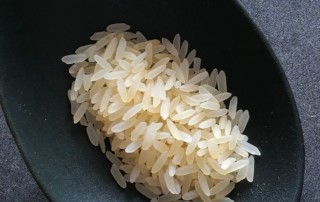DIY Kojic Acid: Skin Brightening Spot Eraser
Kojic acid was an accidental find. People started to notice that the hands of elderly sake brewery workers were soft and free of the dark spots that are the plague of Asian skin. Soon Japanese women were lining up to buy the dregs of the sake brewing process: spent rice brimming with rice koji, sake, and sake yeast. Not long after Shosheido and other skincare companies were extracting the kojic acid and bottling it in their lightening serums, soaps, and peels.
WHAT IS KOJI/KOJIC ACID?
Throughout history, microorganisms have come along and revolutionized civilizations. The story of the fungus Aspergillus oryzae is one such story. A. oryzae (米曲霉, mǐ qū méi, “rice ferment mold”) enzymatically breaks down rice, soy bean, millet and other grains into simple sugars that can then be fermented.* It is the basis of all fermented rice and soy products like rice wine, sake, miso, and soy sauce that are fundamental to cuisine across Asia. The first written record of rice wine (similar to sake) was in China during the Shang Dynasty (17th to 11th century BCE), while the first direct record of this special fungus was during the Zhou dynasty, circa 150BCE.
Qū (曲) is the Chinese character for “ferment”; similar to the Japanese word “koji” (麹) that has been adopted into the English language. They are nonspecific terms. The term “koji” can be used for the collection of fungi, bacteria, and yeasts used in the production of rice and soy products that can include Aspergillus oryzae, A. sojae, A. tamari, Bacillus spp., Lactobacillus spp., etc. depending on the product being made and regional variation.
Kojic acid is the active ingredient present in, and that can be derived from, all of these koji compounds.
Functions of Kojic Acid:
- Impedes melanin production.
- Antibacterial and antifungal.
- Anti-oxidant used to prevent prevents oxidative browning on fruit and natural preservative in food and skincare products.
- May help protect against radiation exposure.
- Shows promise in treatment of certain cancers.
HOW KOJIC ACID “BRIGHTENS” THE SKIN
Kojic acid inhibits the activity of enzymes required in the production of melanin. Melanin is what gives pigment to our skin. The production of melanin gets hyperactive in reaction to stress as in the case of excessive exfoliation, sun exposure, and hormonal imbalance. Cells containing melanin can also buildup, forming spots and patches when blood and lymph circulation are impeded as occurs with hormonal imbalance or aging.
Hyperpigmentation (dark spots, melasma, etc.) = clusters of melanocytes (skin’s pigment cells)
Kojic acid is effective and does not have side effects. Hydroquinone is an additive that works similarly by preventing melanin production. Hydroquinone is stronger in action, but is also harsh on the skin, and can cause a rebound hyperpigmentation effect.
FINDING THE MOST EFFECTIVE NATURAL SOURCE
Japanese sake is similar to Chinese rice wine and other rice-derived alcoholic beverages throughout Asia. You begin with cooked glutinous (sweet) rice. Add rice mold/koji, alcohol yeast, and a little sugar to get it started. Leave to ferment for about a month. Strain out the clear liquid and discard the dregs. The skin beautifying effects were noted in sake brewers who were handling the dregs, known as “sake kasu”. This doesn’t necessarily mean that sake kasu is the best natural form of kojic acid for skincare purposes, but it is a reliable form. (My guess is that the acids in the sake facilitate the action of the kojic acid on the skin.)
Sake kasu is used in homemade Japanese food to ferment pickles and flavor marinades and can be found fresh in the the refrigerated sections of Japanese supermarkets. You can also easily make your own sake with koji and alcohol yeast purchased online. (For rice wine recipes see Medicinal Brewing).
I was playing around with using my homemade rice wine and sake byproducts when I happened upon this mirin kasu:

It was less drying and I got many compliments on my skin the next day after using it only once.
I purchased it at Nijiya in San Diego, 3860 Convoy St, San Diego, CA 92111 (They have product info and recipes here.)
HOW TO USE IT
- I washed my face with 302 Skincare Sensitive Cleanser.
- I put 1 tsp of mirin kasu into a little bowl and misted it with 302 Skincare Calming Mist and rubbed it into my skin, including my face, neck, décolleté, and hands. It is a little messy.
- I brushed the excess rice off my face and applied 302 Hydrating Mask over it. I went to bed.
The next morning my skin was glowing!
*Another Chinese rice mold with health benefits is Monascus pupureus ( 红曲霉, hóng qū méi), also known as red rice yeast. It lowers cholesterol and promotes health blood circulation. It is also used in food production as a colorant and in types of rice wine.

